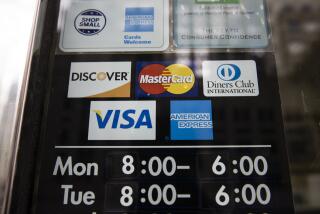Record Number of Bankruptcies in 1991 Forecast : Finances: The American Bankruptcy Institute says individuals and corporations have borrowed too much. Consumer cases are continuing to mount.
Hundreds of millions of credit card receipts from the free-spending 1980s are finally coming home to roost: A record 1 million bankruptcies will probably be filed nationwide this year, the vast majority by individual consumers, according to a report released Wednesday.
It is not the recession but overspending that is mostly to blame, said Samuel Gerdano, head of the American Bankruptcy Institute, which released the estimate in Washington.
“The only way the recession can push you over the edge is if you are already sitting on it,” Gerdano said.
Although the number of business bankruptcies has declined 21% since 1987, bankruptcies by individuals have nearly tripled since 1985 to 811,206 cases in 1991. Consumer cases account for 92% of all bankruptcies.
From July, 1990, through June, 1991, Americans filed 880,339 bankruptcies, up 21% from a year earlier, according to the Administrative Office of the United States Courts. The private American Bankruptcy Institute estimates that the number of bankruptcies for calendar 1991 will swell to a million cases for the first time.
The jump in financial failures is no surprise to the harried U.S. bankruptcy clerk’s office in Los Angeles, the busiest in the nation. There, huddled masses of debtors and creditors wade across a paper-strewn floor toward overworked clerks struggling to manage the huge stacks of paper work. In the first seven months of this year, bankruptcies in the district, which includes Los Angeles, Orange, Ventura, San Bernardino, Riverside, Santa Barbara and San Luis Obispo counties, rose 37% over the same period last year. Frank Goodroe, executive officer of the clerk’s office, says he’s had to add almost 60 staffers to the 272 he had last September. He plans to add another 40 by the end of September and will institute a second shift to handle the increased volume.
Retail bankruptcy filings, from big firms such as Carter Hawley Hale (parent of Broadway department stores) to smaller chains such as Leo’s stereo stores, have helped keep California Central District courts busy.
But Californians are not the fastest-growing group among Americans in the red. Business and personal financial failures from 1985 through 1991 grew fastest in chilly New England and the stumbling Sun Belt. New Hampshire led the way with a 538% increase in bankruptcies, with Massachusetts, Puerto Rico, Florida and Rhode Island seeing bankruptcies more than triple, the institute’s report said.
Among businesses, the most striking change has been the scale of bankruptcies.
In the 1980s, giant corporations joined mom and pop in the bankruptcy lines. The typical size of failing companies today is a staggering 50 times what it was 10 years ago, according to the report.
The reason: Companies during the past decade borrowed beyond their means to buy each other up or prevent corporate predators from attacking.
“Most of the big corporate failures of the 1990s are direct descendants of the corporate debt binge of the 1980s. A higher percentage of corporate cash flow now goes to debt service, leaving many businesses on the edge of bankruptcy whenever there is a drop in sales or a rise in costs,” said Charles Tatelbaum, vice president of the American Bankruptcy Institute.
In Los Angeles, accounting firm Arthur Andersen has increased its staff of bankruptcy professionals to eight from one in the past half year. Noted Mark Rohman, head of the firm’s “corporate recovery” practice: “A good portion of what we do is a slap on the side of the face, telling a company to take a look at reality, to make projections not counting on a lot of good news like they used to.”
Part of the reason for increasing bankruptcies is that banks aren’t there to back up companies as they were in the 1980s, he said. “Credit is so tight that it’s difficult for firms to refinance debt. There are companies going under that wouldn’t have four years ago; someone would have stepped in to save them then. Not anymore.”
There’s no sign of either personal or business bankruptcies abating, Gerdano said. “Contrary to popular belief, the 1990s, which has been called the ‘decade of restraint,’ will yield a bankruptcy increase in an unbroken line and at a record pace,” he said.
More to Read
Inside the business of entertainment
The Wide Shot brings you news, analysis and insights on everything from streaming wars to production — and what it all means for the future.
You may occasionally receive promotional content from the Los Angeles Times.










